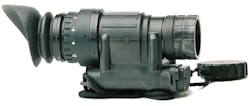Elbit to build light-amplification night vision monocular devices for dark and degraded-visibility uses
ABERDEEN PROVING GROUND, Md. – U.S. Army night vision experts are asking Elbit Systems of America to build monocular night vision devices for nighttime and degraded-visibility conditions.
Officials of the Army Contracting Command at Aberdeen Proving Ground, Md., announced a $27.8 million order Monday to the Elbit Systems of America Night Vision segment in Roanoke, Va., for AN/PVS-14 monocular night vision devices.
The legacy AN/PVS-14 night-vision monocular is in widespread use by the U.S. military and NATO allies. It uses a third-generation image intensifier tube, and often is used hands-free using a head harness or attached to a combat helmet. The AN/PVS-14 can double as a weapons night sight.
The Elbit F6015 is the company's version of the AN/PVS-14 night vision monocular. It enables soldiers to move rapidly and effectively in all night conditions without the need to carry several different types of specialized night-vision equipment.
The night-vision monocular is engineered for handheld, weapon-mounted, and camera-adapted use, and features a Gen 3 F9815 image intensifier tube with variable gain. Its dark-adapted, unaided-eye technology provides situational awareness and close-range vision.
The lightweight, single-battery monocular is being upgraded and replaced by more modern night-vision technologies. The AN-PVS-14 primarily uses light-amplification sensors, while the systems replacing it often combine light amplification and infrared sensor technologies.
On this order, Elbit will do the work in Roanoke, Va., and should be finished by March 2025 . For more information contact Elbit Systems of America Night Vision online at www.elbitamerica.com/night-vision, or the Army Contracting Command-Aberdeen Proving Ground at https://acc.army.mil/contractingcenters/acc-apg/.
About the Author
John Keller
Editor-in-Chief
John Keller is the Editor-in-Chief, Military & Aerospace Electronics Magazine--provides extensive coverage and analysis of enabling electronics and optoelectronic technologies in military, space and commercial aviation applications. John has been a member of the Military & Aerospace Electronics staff since 1989 and chief editor since 1995.
